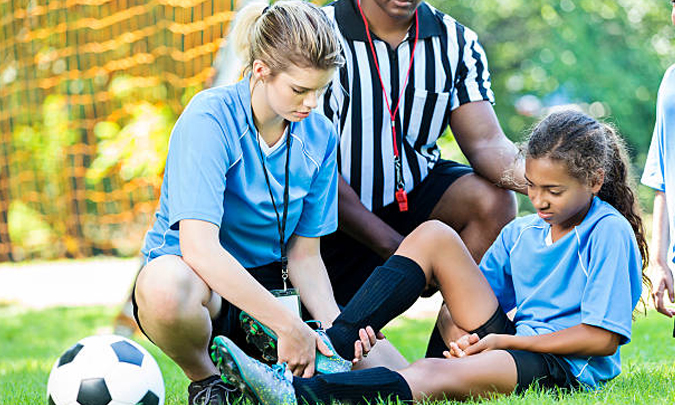
Published on September 15, 2023
Read Time: 9 Minutes
Three Things to Know
- Send your child to school in supportive shoes and any protective gear needed for their commute.
- Encourage children to stretch properly. Yoga is great for increasing flexibility and preventing injuries.
- If your child has a concerning injury, don’t delay treatment. Proper care and treatment in childhood can prevent chronic conditions later in life.
School is back in session, and with that, comes recess and fall sports. While this is an exciting time of year, the return to increased physical activity also brings injuries. The topic of sports injuries and prevention is one that Brett Clayton, PA-C, MHS, is passionate about. Brett is an orthopedic physician assistant (PA) with the Phelps Health Orthopedics Department.
“While in PA school, my master’s work focused on overuse injuries in pre-high school-aged athletes,” said Brett, now in his 10th year with the department. “So, this is something that feels close to my heart. As a father, an athlete and a provider, I love sports, and I love kids. Combining the two can be difficult at times, but it’s an important topic to discuss.”
Read on for Brett’s answers to commonly asked questions on this timely subject.
What are some of the most common injuries that happen at school?
With elementary children, we commonly see playground injuries, often involving the monkey bars, not surprisingly. As a sidebar, we also see trampoline injuries, but those are a home and not school-related injury. Most playground injuries happen as a result of running, tripping or falling, and are not typically sports- or game-related. The most common types of injuries we see are ankle sprains, broken ankles, wrist sprains and broken wrists.
What puts school-age children and teenagers at risk for injuries?

Typically, kids are not as active in the summer. While some of them go to the pool or play summer sports, the reality is that many kids spend a lot of time playing video games or on their phone.
Generally speaking, kids are either active or they're not. There's not a lot of in-between. When kids resume being active in the fall, either on the playground or in a sport, they can more easily injure themselves because they’re simply out of shape. In Orthopedics, we often see this when football, soccer, cross-country, etc. start back up. We see overuse injuries in student athletes because they're overstressing their bodies, getting back into their sport too fast. And we see the same thing with elementary kids and playground equipment. You can chalk it up to “kids being kids.”
What can parents do to prevent these types of injuries?
- Send your kids to school in supportive shoes, with good protective soles: Flip-flops or any shoes made primarily out of foam and cloth, for example, can lead to ankle injuries.
- Protect them on their trip to and from school: While your kids may not think protective gear looks cool, make sure they are wearing helmets and/or knee and elbow pads when riding their bike, skateboard or scooter. The alternative may be wearing a cast.
- Be sure your child gets a sports physical before starting any sports practices.
- Encourage your kids to stretch, the right way: Traditionally, we’ve been taught to stretch before we exercise. However, the studies don't support it. Current research supports stretching after you exercise. Athletes still need to warm up their muscles properly beforehand, though. I suggest a light jog or some kind of light cardio before getting into heavy exercise. Then, stretch afterwards, and you’ll hopefully prevent an injury.
How can kids (and adults) keep themselves limber and flexible?
I’m a big advocate of yoga, for kids and adults. (Yoga is a mind-body practice that involves physical postures, breathing exercises and meditation, aimed at promoting physical and mental well-being.) I'll be honest; I used to laugh at yoga. I'm a 6'5”, 220-lb. big guy, but I started doing yoga a couple years ago. My wife is an avid yogi. Yoga involves isometric strengthening, where you contract your muscles without changing their length or moving a joint. This helps build strength and stability in specific muscle groups. I always joke that I only do yoga after my lavender bubble bath, and the curtain is drawn so nobody sees it, but honestly it’s great.
Benefits of yoga for kids (and adults) include improved flexibility, better concentration, reduced stress, enhanced body awareness and the promotion of a healthy lifestyle. Yoga doesn’t have to be mystical; it emphasizes stretching and using your body weight for strength. If you’re interested, YouTube has good, free resources.
Beyond yoga, do you have any specific stretching advice?
Unfortunately, I see an increasing number of kids complaining of back pain at younger ages. So, it’s even more important for kids to stay mobile and get moving. I see a lot of back and neck injuries and irritation. Screen time also is an issue. Between computers, tablets and phones, kids are looking down often. Children need to stretch and stay active. I realize back stretches may not be cool. Teenage boys, for example, may not want to stretch, but these are often the same boys complaining of back pain. Some back pain can be lessened by simply stretching your glutes and hamstrings.
What are the symptoms of an ankle sprain? Can I take the “wait and see” approach?
When kids are young, their growth plates are soft. So, if their bones aren’t healing, we need to first rule out a break or fracture. Their ligaments are often stronger than the actual soft bone where the bones are growing. Ankle sprains usually happen with a rolling injury. For example, you turn your foot in or out, either from jumping and landing on somebody's foot, or by rolling off of a curb and it causes pain on either side of the ankle.
We have bumpy bones on both sides of our ankles, which will be tender with an injury. If the ankle swells or bruises, you’ve most likely made the ankle bleed. You've torn something, you've broken something, and bruising is a sign that something's been damaged enough that it's bleeding and should be evaluated. Generally speaking, if it hurts to bear weight on your ankle, you should have it checked out. If you roll your ankle, but you can walk on it without too much pain, then you can give it a little time. But if it hurts to put weight on it, you should have an X-ray and have it evaluated.
What can parents do at home for sprains?
Consider the mnemonic (memory aid) RICE, where the “R” is for rest. So rest, ice, compression and elevation. Have your child lie down on the couch and elevate their foot above their heart. Wrap an ACE wrap around the affected ankle (including their heel), to keep it compressed. Put some ice on it, as well.
Whether you're going to the doctor or not, these are appropriate at-home treatments. RICE will always be beneficial, even after a surgery.
What does treatment look like for an ankle sprain?
When you come into the Orthopedic clinic, we will evaluate your child. We also have our X-ray machine conveniently located in the office, to ensure everything looks OK. Treatment will depend on the severity of the child’s symptoms and their injury. We may recommend not putting any weight on it for a few weeks. If it’s a severe sprain but we don't see anything broken, we may put them in one of those big “Terminator” boots and let them walk on it. Other times, we'll put them in a boot and advise them not to walk on it. And sometimes, we'll put a child or teenager in a lace-up brace that allows them to wear a regular shoe.
As far as recovery time, it could be 4 weeks, or it could be 8 weeks. We understand that kids are anxious to get back to playing their sport. However, if they don’t take the time to sit out and let their injury heal when they’re young, it could become a chronic problem when they play in high school or beyond. Appropriately treating injuries as they happen, as opposed to putting treatment off, is critical, as chronic injuries are difficult to heal, especially as children grow.
What is a stress fracture?
Stress fractures happen when our bones are overstressed. When we lift weights, run and exercise, we naturally stress and strain our bones. These activities put weight on the bones, and the muscles, tendons and ligaments pull on our bones. Younger children, as I mentioned earlier, have softer bones. On an X-ray, you may not even see a stress fracture. You may notice a change, but not a crack. Sometimes, a stress fracture will show up on an MRI (magnetic resonance imaging). Stress fractures are basically pending fractures. If you continue to exercise as normal, a stress fracture may end up as a regular fracture or broken bone. In other words, we need to rest and let the bone heal. Runners are particularly prone to stress fractures, in their shins and their ankles.
How do I know if my child has a stress fracture?
Runners, for example, might say, "Oh man, I think I have shin splints. My shins really hurt, and the pain isn’t going away." Or, another athlete might say, "My ankle just hurts. It hurts to run, it hurts afterwards, but it doesn't hurt to move it." So, while you might not have pain when you move the joint, you may have pain when pressure is put on the bone or joint. It can be tricky, which is why these types of symptoms need to be evaluated.
How do you treat a stress fracture?
Simply put, a stress fracture requires rest. That’s the hardest part with these injuries. Often times, a stress fracture doesn’t need surgery. We just need to rest, but we don’t want to. We want to keep playing. Kids will ask, "Can I wear a brace and just keep playing?” But the best medicine for most of these injuries, is to immobilize, or rest, the bone. Your body is pretty good at healing itself, given the chance. Surgery is not always your best option. I understand that taking time off of sports is tough for athletes, coaches and parents. No one wants to miss a game or games. I played three sports in high school, so I get it.
Finally, does a patient need a referral from their primary care provider to make an appointment with an orthopedic surgeon or provider at Phelps Health?
Some patients may need a referral, depending on their insurance. It’s always best practice to call your insurance provider to find out, one way or another. We're always happy to see them and help in any way we can.
Do Your Part to Prevent Injuries
Encourage children to stretch before physical activity and to rest, when needed. If you have questions about an injury, contact your primary care provider or the Orthopedics clinic at (573) 364-5633.